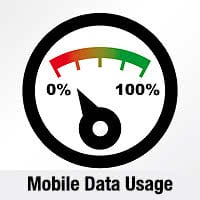How to Reduce Data Usage on Your iPhone
 Mobile data comes at a costly price to some, which is why we’ve compiled a guide on how to decrease data usage on iPhone and make the most out of your contract’s data cap. Keeping your mobile data allowance in check is the best way to assure that your mobile internet access won’t suddenly drop out when you need it the most!
Mobile data comes at a costly price to some, which is why we’ve compiled a guide on how to decrease data usage on iPhone and make the most out of your contract’s data cap. Keeping your mobile data allowance in check is the best way to assure that your mobile internet access won’t suddenly drop out when you need it the most!
Monitoring your data usage
To avoid paying additional costs for data upgrade buckets, keep your monthly usage in check by analyzing the data. This can be done via two main methods:
- Check your data usage through the Settings app by looking at the section titled Mobile Data.
- Use a third-party app to check your data usage in more detail and have it reset automatically and/or warn you when you hit a self-determined limit.
Toggling mobile data on a per-app basis
Go to your Settings app, then select Mobile Data and scroll down until you see a list of apps that are potentially using the mobile data connection. Evaluate whether these apps truly need mobile internet access and disable the corresponding toggle when applicable. This will make sure that mobile data usage is only active for the use cases that actually apply to your needs. In another article we show you how to reduce high data usage on your iPhone.
Disable Background App Refresh
Having the most recent content available right away after launching an app is comfortable, but costly in terms of all of the data that is transmitted in the background. Apps retrieve images, statuses and other updates while you are not using them, so that all of this content is ready without having to wait for it. This can cause high data usage and should be disabled if you are on a tight limit. In order to turn off “Background App Refresh”, go to your Settings, General and select Background App Refresh to configure the feature.
Use WiFi-Hotspots when available
Using free and open wireless hotspots is a great way to reduce your mobile data usage. When visiting a restaurant or café, try asking for a guest Wi-Fi network. This counts for hubs such as railway stations or airports as well. Join a network by going to Settings and tapping Wi-Fi, then selecting the name of the network.
Disable Wi-Fi Assist
Since iOS 9, your iPhone has been using the cellular data connection to compensate for lack of signal strength in a Wi-Fi connection. This means that mobile data usage increases as soon as you lose contact to your router. In practice, this has often caused outrageous amounts of data being used up without the knowledge of iPhone users. We recommend disabling the Wi-Fi Assist feature in Settings > Mobile Data to make sure that doesn’t happen to you.
Use apps in offline mode
Many apps support downloading the content beforehand, store it on the device in the form of a cache and viewing e.g. news feeds or videos while offline. This enables the user to make use of Wi-Fi networks without putting stress on his data cap, then view the content outdoors.
Disable push for email
Let’s be honest: When have push notifications for email actually solved a real issue for you? You’re probably best off to disable push for email and go for manual or scheduled fetching. This will not only lessen the amount of interruptions in your day, but also save some battery life and conserve your data cap for far longer, as you will be in full control of downloading your email whenever you like. Which in turn means that you can download email while connected to a Wi-Fi network of your choice. Go to Settings > Mail, Contacts, Calendars > Fetch New Data and turn off the toggle labeled Push.